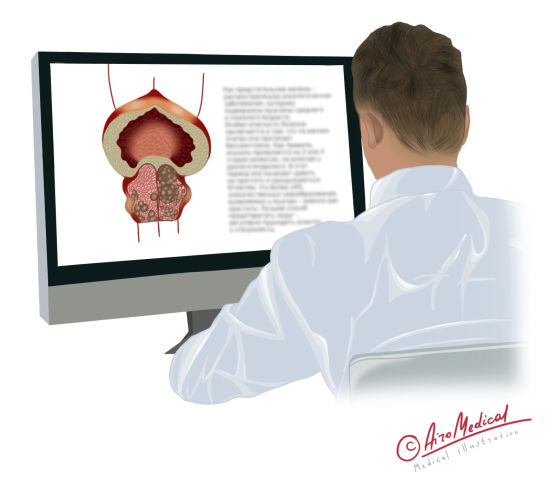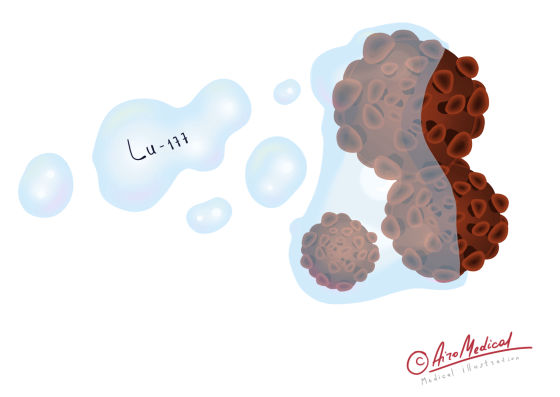Lutetium 177 PSMA Therapy FAQ: Getting Ready for the Treatment
Lu-177 PSMA therapy is targeted radionuclide therapy used to treat prostate cancer. PSMA is an abbreviation for prostate-specific membrane antigen, a protein highly expressed in prostate cancer cells. Lu-177 is a radioactive isotope attached to a molecule that binds specifically to PSMA, delivering high doses of radiation into the cancer cells. This therapy is minimally invasive, has few side effects, and effectively reduces symptoms and improves the quality of life for patients with advanced prostate cancer.
You probably already know basic things about Lu 177 treatment, and here we try to answer the most frequent questions that appear in our patients with prostate cancer. In other words, we will cover things that still need to be explained in our current articles.
Finding the correct info for Lu 177 with AiroMedical
Lu-177 is a radioactive isotope used in nuclear medicine. The correct information is essential to ensure that it can be utilized safely and effectively in medical procedures and to reduce the risks and side effects that could happen to patients and medical staff. Accurate information also helps ensure that the proper safety precautions are taken and that the results of medical procedures using Lu-177 are reliable and consistent.
 The information in the database comes from hundreds of hospitals chosen based on their annual statistics, the number of procedures they do, their equipment, qualifications, success and problem rates, experience, certifications, and so on. Some clinics specialize in therapy with Lu-177. The cost is crucial when deciding on a hospital because prices range widely depending on various criteria.
The information in the database comes from hundreds of hospitals chosen based on their annual statistics, the number of procedures they do, their equipment, qualifications, success and problem rates, experience, certifications, and so on. Some clinics specialize in therapy with Lu-177. The cost is crucial when deciding on a hospital because prices range widely depending on various criteria.
Our database boasts thousands of physicians, including those specializing in the treatment of prostate cancer through Lutetium 177 therapy. These doctors boast a wealth of experience, ranging from 20 to over 50 years. Some offer the convenience of remote consultations, while others can arrange a prompt in-person appointment.
We're asking about Lu-177 treatment by Dr. med. Stefan Dresel is a Professor and Head of the Radiology, Radiotherapy, and Nuclear Medicine Specialist Group at Helios Hospital Berlin-Buch in Germany. With 32 years of experience and over 150 research publications, he is a highly respected expert in his field and kindly agreed to answer our questions.
What is Lutetium 177 Dotatate?
Lutetium 177 Dotatate is a highly targeted cancer treatment that uses a combination of a radioactive substance and a unique molecule to attack advanced prostate cancer and neuroendocrine tumors. Read more about Lutetium 177 Dotatate treatment here.
What is Lutetium used for?
Radioactive substances are used in medical treatment to target and attack cancer cells, specifically neuroendocrine tumors and advanced prostate cancer. It emits high-energy particles to destroy cancer cells from the inside while minimizing harm to healthy tissue. Get more about the condition where Lutetium is used here.
What are lutetium Lu 177 Dotatate side effects?
The side effects of Lutetium Lu 177 Dotatate and radiotherapy can be similar, as both forms of treatment deliver radiation to the body. However, the exact side effects can vary depending on the specific treatment, dose, duration, patient's health, and other factors. Find out more about Lu 177 adverse effects in our article.
Where was Lutetium discovered?
Carl Auer von Welsbach discovered Lutetium in Austria and Georges Urbain in France in 1907 and 1908, respectively. Lutetium-177 (Lu-177) is a radioactive isotope of Lutetium that was found in the 1950s. It has been studied for its perspective use in nuclear medicine and, more recently, as a therapeutic agent for delivering targeted radiation therapy to cancer cells.
 Swiss pharmaceutical company Novartis invested in research of Lu 177. The European Medicines Agency (EMA) in 2017, and the Food and Drug Administration (FDA) approved Lutathera, a Lu-177-based product, in 2018 for treating neuroendocrine tumors. In 2022, the FDA for metastatic castration-resistant prostate cancer (mCRPC) treatment approved Pluvicto, another Lu-177-based product. The approval was based on VISION study results, which showed that Pluvicto was safe and effective in treating mCRPC.
Swiss pharmaceutical company Novartis invested in research of Lu 177. The European Medicines Agency (EMA) in 2017, and the Food and Drug Administration (FDA) approved Lutathera, a Lu-177-based product, in 2018 for treating neuroendocrine tumors. In 2022, the FDA for metastatic castration-resistant prostate cancer (mCRPC) treatment approved Pluvicto, another Lu-177-based product. The approval was based on VISION study results, which showed that Pluvicto was safe and effective in treating mCRPC.
The VISION trial was a study that evaluated the effectiveness of a treatment called 177Lu-PSMA-617 in improving the overall survival of patients with progressive metastatic castration-resistant prostate cancer. VISION was a multi-center study conducted in 84 locations (52 in North America and 32 in Europe). The patients were randomly assigned to receive either 177Lu-PSMA-617 and standard care or just standard care alone. The study found that the patients who received 177Lu-PSMA-617 significantly improved overall survival (15.3 months vs. 11.3 months) and image-based progression-free survival compared to those who only received standard care. Nearly half (46%) of the patients in the 177Lu-PSMA-617 group saw a decrease in their PSA levels of more than 50%, while only 7.1% of patients in the control group experienced the same results.
These approvals demonstrate the potential of Lu-177 in cancer treatment and its ability to improve outcomes for people with cancer. Now, a lot of clinics worldwide use Lu-177 for PSMA therapy. At AiroMedical, we can choose the most suitable program, clinic, and doctor.
What is Lu 177 Dotatate treatment package include?
Before the treatment, patients undergo various tests and scans to assess the extent of their cancer and ensure that their organs, such as the liver and kidneys, are functioning correctly. That's why laboratory tests, such as a complete blood count, biochemical analysis of blood, inflammation blood tests, urinalysis, and PSA test, are performed to assess the patient's organ function and check for any underlying conditions that could affect the treatment. Diagnostic tests, such as a Ga-68 PSMA PET CT scan and renal scintigraphy with 99mTc-MAG3, are then performed to determine the extent of the prostate cancer and to ensure that all relevant information is taken into account before the treatment begins.
During the treatment, the patient is given an intravenous injection of Lu 177 and stays in a protected ward for two days while the radioactive particle works to destroy the cancer cells. They may also receive drugs to protect their thyroid gland and kidneys and reduce the side effects.
The therapy can result in significant reductions in the size of prostate cancer metastases and, in some cases, complete remission. In some cases, repeat Lu 177 PSMA treatment sessions may be necessary to achieve the desired results. It is important to note that the patient's belongings will not become radioactive, and the radiation zone will not exceed 1 millimeter. After the therapy, the patient will undergo a control examination and dosimetry to assess the treatment results.
In addition to the cost of radiopharmaceuticals, essential medicines, and materials, patients may also need to pay for nursing services, discharge medical records, and any further recommendations.
It is important to note that the exact process and cost of Lu 177 PSMA treatment can vary depending on the patient's circumstances and the healthcare facility where the treatment is performed.
What specialists prescribe and do Lu-177 therapy?
Oncologists and nuclear medicine doctors typically prescribe Lu-177 therapy. Oncologists specialize in cancer treatment and often focus on a specific type, such as prostate cancer.
Nuclear medicine doctors are specialists who use radioactive materials in medical procedures, including cancer treatment. They are trained to understand the properties of these materials and how they interact with the human body, making them well-suited to prescribe and oversee Lu-177 therapy.
In the case of Lu-177 therapy, a urologist may also be involved in the treatment plan, particularly if the patient has prostate cancer. It is because urologists specialize in treating diseases that affect the urinary system, including the male reproductive system, where prostate cancer is commonly found.
A team of specialists is often involved in administering Lu-177 therapy because the treatment uses radioactive material, which can have both therapeutic and potentially harmful effects on the patient. The specialists work together to carefully evaluate the patient's medical history and condition to determine if Lu-177 therapy is safe and effective, monitor the patient's response to treatment, and manage any potential side effects.
Here are some nuclear medicine doctors based on our rating
Is Lutetium 177 treatment inpatient or outpatient?
The treatment typically involves administering a small amount of Lu-177 through targeted radionuclide therapy, which involves injecting the substance into the patient's bloodstream.
In some cases, Lu-177 treatment may be classified as a "hybrid" procedure involving inpatient and outpatient elements. In these cases, the patient will receive the injection and then be required to stay in an isolation ward for three days, after which they can return home.
The type of treatment is based on several factors. There are the patient's overall health, the type and cancer stage, and the dose of Lu-177. The patient's medical team will provide more information on what to expect and make an individualized treatment plan.
Is Lutetium radioactive?
Lu-177 is a radioactive isotope with many medical uses, especially for cancer treatment. It can be used as a radioactive tracer, which makes it possible to see and keep track of diseases like cancer. For this, a small amount of the substance is injected into the patient's bloodstream to send a therapeutic dose of radiation to the affected area.
But because Lu-177 is radioactive, it can give off harmful ionizing radiation and should be handled with care. Patients treated with Lu-177 are usually kept in an isolation ward for three days after getting the drug so that they spread it to other people.
What is a radiation precaution and isolation?
Because of its radioactivity, some restrictions are used. Patients receive simple instructions to minimize the radioactive transfer. After a few days in the isolation ward, the patient should:
- Shower every day for at least 7 days after treatment.
- Maintain a distance of 3 feet from others for 7 days for children younger than 10 years old and pregnant women.
- Avoid sexual activity for 7 days.
- Use effective birth control methods during treatment and for 6 months after.
- Sleep in a separate bedroom from infants or children for 7 days and from pregnant partners for 15 days.
- Avoid close contact (less than 3 feet) with children and pregnant women for 7 days.
- Wash sheets and clothes that contain sweat, blood, or urine separately from another household laundry for one week. Rinse each load with an additional cycle.
Patients ask if they can keep their luggage while in isolation at the hospital. The answer is – yes. Just follow the recommendations above.
Why do patients search for Lu PSMA treatment overseas?
Here are some reasons why patients may search for Lu PSMA treatment overseas:
- Unavailability of treatment in their home country: Lu PSMA treatment may not be widely used in some countries. Or, it may still be in the experimental phase. Patients may travel to countries where the treatment is readily available.
- Low capability and experience: Some patients may feel that their home country's medical facilities and healthcare professionals need more knowledge and ability to provide the best treatment for their condition.
- High bureaucracy: In some countries, obtaining medical treatment can be complicated and time-consuming, with much bureaucracy and red tape. Some patients may travel to countries where the process is more straightforward.
- Different qualification criteria: The criteria for qualifying for specific medical treatments can vary from country to country. Some patients may travel to countries where they are eligible for Lu PSMA treatment when they may not be eligible in their home country.
- Cost: The price of medical treatment can vary significantly from country to country, and some patients may choose to travel to countries where the cost of Lu PSMA treatment is lower.
- Quality of care: Some patients may believe that medical care and facilities available in other countries are higher than in their home country.
- Privacy and confidentiality: Some patients may prefer to keep their medical treatment private and may travel to a country where they can receive treatment anonymously.
It's important to note that these factors can affect a patient's decision to seek medical treatment overseas. And it is important to weigh carefully against the potential risks and difficulties involved in traveling for medical care.
Luthathera is available in USA and Canada (nearly 250 sites). But there are very few hospitals in the UK that offer Luthathera treatment.
What are the leading countries offering Lu-177?
Major hospitals and clinics in Israel, Turkey, Germany, Australia, France, Italy, the Netherlands, Korea, Spain, India, and the United States offer Lutetium-177 therapy. Currently, at least 216 clinical trials are performed worldwide.
The leaders in Lutetium research are:
| Region or country | Number of studies |
|---|---|
| USA | 83 |
| Europe | 79 |
| East Asia | 27 |
| Australia | 24 |
| Canada | 10 |
Information on the exact number of procedures performed in each country can be challenging, but for example, Germany has more than 500 people annually.
Where Lutetium treatment can be offered?
How is Lutetium 177 made?
Lutetium-177 (Lu-177) is produced through a process called nuclear medicine production. It involves using a nuclear reactor or a cyclotron to produce the radioactive isotope. Here is a general overview of the process of creating Lu-177:
- Starting material: The starting material used in the production of Lu-177 is usually the stable isotope Lutetium-176 (Lu-176).
- Neutron capture: The Lu-176 is irradiated with neutrons in a nuclear reactor. This causes the Lu-176 to capture a neutron and become Lu-177.
- Separation: The Lu-177 is separated from the other radioactive and non-radioactive materials produced in the reaction using a chemical fork. It involves using chemical methods to separate the Lu-177 from the other materials based on differences in chemical properties.
- Purification: The Lu-177 is purified further to remove any impurities that may be present.
- Quality control: The final product is subjected to various tests to ensure sufficient purity and activity for medical applications.
The production of Lu-177 is highly regulated. It requires specialized expertise and equipment. This help to ensure the safety of the personnel involved and the quality of the final product.
What are similar radionuclide therapies available?
Several other radionuclide therapies are available for prostate cancer treatment, including
- Actinium-225 is a radioactive isotope used similarly to Lu-177 for the treatment of prostate cancer. It works by emitting alpha particles, which can kill cancer cells.
- Radium-223 is a radioactive isotope used to treat bone metastases in prostate cancer. It works by emitting alpha particles, which can kill cancer cells in the bone.
- Iodine-131 is a radioactive isotope used to treat prostate cancer that has spread to the lymph nodes. It works by emitting beta particles, which can kill cancer cells.
The choice of radionuclide therapy for the treatment of prostate cancer will depend on several factors, including the stage and progression of the disease, the patient's general health, and the presence of any other medical conditions. A medical professional, such as a radiation oncologist or nuclear medicine specialist, can help determine the best course of treatment.
References:
- Elias Chandran, William D. Figg, Ravi Madan. (2022) Lutetium-177-PSMA-617: A Vision of the Future. Cancer Biology & Therapy 23:1, 186-190
- Sartor O, de Bono J, Chi KN, Fizazi K, Herrmann K, Rahbar K, et al. Lutetium-177-PSMA-617 for metastatic castration-resistant prostate cancer. N Engl J Med. 2021;385:1091–103
- Leibowitz R, Davidson T, Gadot M, Aharon M, Malki A, Levartovsky M, Oedegaard C, Saad A, Sandler I, Ben-Haim S, Domachevsky L, Berger R. A Retrospective Analysis of the Safety and Activity of Lutetium-177-Prostate-Specific Membrane Antigen Radionuclide Treatment in Older Patients with Metastatic Castration-Resistant Prostate Cancer. The Oncologist. 2020 Sep;25(9):787-792. doi:10.1634/theoncologist.2020-0100. PMID: 32430954.
- Vogel WV, van der Marck SC, Versleijen MWJ. Challenges and future options for the production of lutetium-177. Eur J Nucl Med Mol Imaging. 2021 May 11;48:2329-2335. doi: 10.1007/s00259-021-05342-9.
- Salner AL, Blankenship B, Dunnack H, Niemann C, Bertsch H. Lutetium Lu-177 Dotatate Flare Reaction. Adv Radiat Oncol. 2021 Jan-Feb;6(1):100623. doi:10.1016/j.adro.2020.11.008. PMID: 33490736.
- Hennrich U, Eder M. [177Lu]Lu-PSMA-617 (PluvictoTM): The First FDA-Approved Radiotherapeutical for Treatment of Prostate Cancer. Pharmaceuticals (Basel). 2022 Oct 20;15(10):1292. doi:10.3390/ph15101292. PMID: 36297404.
- Kurth J, Krause BJ, Schwarzenböck SM, Stegger L, Schäfers M, Rahbar K. External radiation exposure, excretion, and effective half-life in 177Lu-PSMA-targeted therapies. Radiation Oncology. 2018 Apr 12;8:32. doi:10.1186/s13550-018-0386-4. PMID: 29651569.
- Ludwike W. M. van Kalmthout, MD, Esmée C. A. van der Sar, MD, Arthur J. A. T. Braat, PhD, Bart de Keizer, PhD, and Marnix G. E. H. Lam, PhD. Lutetium-177 PSMA therapy for prostate cancer patients—a brief overview of the literature. Tijdschrift voor Urologie. 2020;10:141-146.





